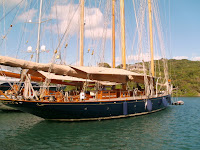We arrived in Barbuda after a 33 nm sail from the North Sound of Antigua. Barbuda is part of the county of Antigua and Barbuda. Check out http://www.treasureislands.com/ and http://www.barbudaful.net/

Fellows cruisers aboard S/V “Tiger Lilly” had proceeded us, so there was the rare opportunity to get pictures of the “Charlotte D” underway and anchoring. Thank you.


"Tiger Lilly" was fortunate enough to have boated a sizable mutton snapper inbound to Barbuda and generous enough to share it with us. Thank you again.


There are so many things to do aboard a cruising sailboat!



On Barbuda “Life is a Beach”. Nearly the entire shoreline is occupied with beaches. The so-called “Eleven Mile Beach” seems endless and to walk it's length is a magnificent hike. Check it out on Google Earth at 17-39.4N 061-51.5W.

This beach features a distinct pink tint, especially at the surf line, due to high concentration of small fragments of pink shells.

The Barbuda OutBar has a delightful location, with cold beer, few clients and stunning view. They offer food too. We will be back!

The 11 mile beach is the usual starting point for visits to the Frigate Rookery. Catherine and I did not visit there this time, but happily obtained pictures from “Serafina of Maldon” (Rob and Sara) and from “Cat Tales” (Laurie and Dawn), which we include here with their permission. Thank you.




One could stay anchored off the 11 mile beach indefinitely if it were not for the periodic occurrence of ocean swells propagating south from low pressure systems passing well to the north. These swells can be 2 to 4 m (7-13ft) in height and sweep directly into the anchorage. This makes living aboard impossible and prevents landing a dinghy on the beach. So, as the swells approached we moved to the south end of Barbuda, where we found another beautiful beach near Cocoa Point. There is even better protection from ocean swell at the anchorage near Spanish Point.
From Cocoa Point we hiked the interior 16 km (10 miles) to Codrington. This is the one town of Barbuda and where most of the 2000 residents live. There are 7 churches for 2000 residents. I guess so all can attend at the same time.


In Codrington we rented bicycles from Jonathon. www.barbudabiketours.net This allowed us to do further inland exploration.

There is abundant “wildlife”, much of it introduced by Codrington; duck, guinea fowl, pigeon, deer, turtle, donkey and horses, stocked for hunting. The donkey and horse are free range. The humans all dwell inside fences.


Many residents have delightful vegie and flower gardens.

We biked to the ruins of the Highland House (Codrington's Estate).


There are attractive ruins of old fortifications.


We found the very large trunk of a tree on the south coast, like nothing that grows here. Came across the ocean from where?

It is clear that the slump of tourism has hit hard in Barbuda. Many resorts are closed, including the K-Club and Palmetto Beach Hotel. The Cocoa Point Lodge and the Lighthouse Bay Resort are open, but seem nearly devoid of guests (we saw more staff than customers).
Many restaurants are also closed, including Jackie's Wa O'moni's Best, but there is still Uncle Roddy's. This is a 5 km (3 mile) walk or bike ride from the Cocoa Point anchorage, but well worth the effort. Roddy makes a “wicked good” rum punch, the beer is ice cold and he is an excellent cook. Furthermore, the beach front location is perfect and we found him a very pleasant gentleman.


The Palm Tree Restaurant and Bakery is a wonderful meeting place.

The street food venders seem to be surviving better than establishments with greater overhead. We particularly enjoyed “The Jerk Man”. He served us venison stew with green salad, macaroni pie, peas and rice. He also offers fish, chicken, conch and tortoise.
Food markets are restocked on Friday when the ferry arrives, so go on that day for fresh fruit and vegies.
The island of Barbuda was privately owned from the earliest colonial times by the Codrington Family, beginning 1685, who used it to supply their sugar plantations in Antigua with food and slaves. When slavery was ended, the freed slaves were still trapped, because all land was privately owned and they were left with no land, no jobs and no law. Eventually, Antiguan law was applied. Land was not distributed but rather held communally. As explained to us by residents, land cannot be bought or sold, only leased (something like “a dollar and other considerations, 99 years”). When a home, business, or even large resort is built, the structures are owned but not the land. Consequently, all construction is paid in cash, because banks are not eager to issue unsecured loans for building on vacant leased lands. This has very much limited development and certainly has prevented “McDonaldization”.
On February 13 we departed Barbuda for the 33 nm sail back to Antigua for brief stop at Nonsuch Bay before continuing on to Marie Galante, Guadeloupe. Enroute we boated a 30 cm (12”) jack (keeper) and a 75 cm (30”) barracuda (released).


Once offshore we deployed the skirt lure made by Tom of “Tiger Lily”. This was a very productive lure. It hooked the only fish trap pennant on our route. This stripped the line from the reel and broke the rod holder. So we lost overboard the lure, line, rod, reel, and rod holder, all due to our failure to keep a sharp lookout and secure the normal tether to the rod. “No shortcut goes unpunished.”
Peter and Catherine aboard S/V Charlotte D.
“Some die to go to Heaven. Better to stay alive and enjoy Heaven On Earth.”
Ogden Nash.






























